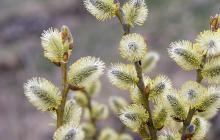Right in front of the monastery is a rural cemetery. The village of Voronets is very close to the monastery.
By the way, the original walls have not been preserved. The monastery was besieged many times, but the church was always left untouched.
Fortress walls.
Tower from the back.
Church of St. George. the main shrine of the monastery. The paintings on the outer walls were painted by Suceavian masters. In general, history has not preserved the names of these artists, the most famous is considered to be a certain Thomas, also from Suceava. But that's where these masters studied, apparently not without Russia. And many of the very names of villages and rivers in this part of Romania have Slavic roots. The word Voronets is clearly not Romanian and is of Slavic origin. The influence of Russia (in particular the Moscow kingdom, the Kyiv clergy and Galician merchants (they had the shortest and most efficient trade route along the Dniester) is undeniable, the paintings on the wooden facade of the church in Drohobych came to mind (which are barely visible now). Russia was also the main trading partner of Wallachia and the Moldavian Principality.
And Moldovan Gothic (as some call it). Original and unique temples... The paintings are barely visible on the north side of the temple. Under Stephen the Great, no one painted temples on the outer walls. The initiator was Prince Petru Rares, under him the outer walls of churches were first painted, again .. when the Moldavian principality actually became a vassal of the Ottoman Empire.
South side. Fresco of the Last Judgment, it was painted in 1547. The blue color prevails, often the church is called the Blue Church.
Unique paintings.
Next to real animals, a lion and an elephant, one can see a dragon and a pegasus (winged horse).
Inside the church, ancient frescoes were also preserved, but it was difficult to get there. Almost the entire church (it is not very spacious, the thickness of the walls is still the same) was packed with people, believers who came here from other villages, tourists and local, Voronets, people, so the photo failed to do
Wooden gate to the cemetery.
There is a small wooden chapel here.
the village of Voronets and the foothills of the Carpathians.
The Voronets River is sleeping now. But in spring, the flow of water is ten times greater, and floods also occur. Such are the barriers from the blocks stuffed with stones.
the town of Redeuts (Ukr. Radivtsy) (many towns and villages near Suceava also have Ukrainian names, by the way, at the entrance to the city there is a sign in two languages.) And the monastery of Bogdan. One of the oldest churches of the Moldavian Principality has been preserved from the once monastery. It is dated 1359.
There is almost no light inside.
Again, the interweaving of Gothic, Byzantine architecture and Moldovan style. This is probably the oldest church of such a merger.
Old frescoes on the walls
And here is the iconostasis of new times.
Bell tower 1781.
Another old church in the town of Siret. (from Radivtsy 12 km) It was built in the 14th century. Siret is the first capital of the Moldavian Principality, in close proximity to the Ukrainian-Romanian border. By the way, before the First World War, about 45% of Ukrainians lived in the city. And now there is a Ukrainian Greek Catholic church in Siret, and there are graves with Ukrainian surnames in the cemetery. There are buildings in Siret from the Austrian era and once there was a princely castle (which has not survived)
Inscription in three languages. Romanian, English and Ukrainian.
The Church of the Holy Trinity was built in 1358. It is considered the oldest church in the Principality. And here the Byzantine style is more pronounced. The complete absence of gothic.
Voronets Monastery in honor of the Holy Great Martyr George the Victorious is located at a distance of 36 km from the city of Suceava. It was built between May 26 - September 14, 1488, in four and a half months, which was a record for that time. This is one of the most valuable monasteries founded by Stefan the Great. Few monuments of religious architecture in the north of Moldova have been preserved in their original form. The narthex of the church was added in 1547 by Metropolitan Gregory Roshka; at the same time, the external painting of the facades was carried out. The outer walls are painted from the foundation to the cornices, while the western wall of the vestibule is completely closed.
The church is small in size (25.5 m without a vestibule, 7.7 m - the length of the naos and pronaos, 10.5 m wide with side apses).
At first, the Voronets Monastery was a male monastery, but monastic life was interrupted in 1786. Restored in 1991, the monastery resumed its activities as a convent. The church is built of stone, has the shape of a shamrock, and the interior space is traditionally divided into the altar, naos, pronaos and vestibule. The apses of the naos are not very pronounced; The naos is separated from the pronaos by a wall more than 1 meter thick.
The interior and exterior painting, made in 1534-1535 and 1547, impresses with pictorial techniques and colors, is characterized by the harmony of colors, compositional dynamics and monumentality. All external painting and the famous blue color of the Voronets monastery have no analogues in the world.
The interior painting of the monastery dates mostly from the time of Stefan the Great; The votive picture in the naos depicts Stefan the Great next to his wife Maria Wojkitsa, a little girl and the future ruler Bogdan.
Scene doomsday, painted in 1547 on the western façade, gave the monument its name Sistine Chapel of the East; stage on the south side Tree of Jesse; on the left side of the entrance you can see the images of Metropolitan Gregory Roshka and the pious Daniel the Hermit, and above him, next to the Scripture, there is an iconographic composition Deesis. Some of the biblical scenes presented by the artists were secularized, thus the lives of the saints were brought closer to Moldovan customs and practices. So, Adam plows the earth, and Eve spins. The scenes of the martyrdom of St. John the New of Cetate Albe and the delivery of the relics to Suceava are filled with special drama.
Experts believe that in terms of scale, decorative effect and brilliance of polychrome, the painting of the Voronets monastery is higher than the compositions of Athos and Camposanto (Pisa), worthy of being on a par with the Sistine Chapel in Rome, with the painting of San Marco (Venice), Siena, Assisi, Orvieto. The originality of the artist lies in his boldness, which allowed him to depict Moldovan musical instruments (buchum, kobza), the local landscape, national clothes and towels in biblical scenes - all against a blue background - the unique blue of Voronets.
The Voronet Monastery was built on the site of a wooden church where Daniil the Hermit, one of the most revered saints of Moldova, lived. He lived in a cell carved into the rock in the valley of the Putna stream, which has survived to this day, and later in a cell near the newly built Voronets monastery, of which he was rector. Ion Neculce in his book "O samă de cuvinte" (Selected Words) claims that Daniel was one of the confessors and advisers of Stefan the Great, to whom he suggested the idea of building the Voronets monastery. The disciples and believers considered Daniel "holy" after death. His face with a halo was painted for the first time on the outer wall at the entrance to the Voronets church. The grave of Daniel the Hermit is located in the church, as is the grave of Metropolitan Gregory Roshka, who is considered the second church warden.
The stone bell tower contains two bells donated to the monastery by Stefan the Great. In the courtyard, traces of other medieval buildings are visible: cells, gospodar quarters, now destroyed.
Voronet Monastery is one of the first Moldovan monuments, distinguished by its own style, a kind of synthesis of Byzantine, Gothic and national elements.
Moscow-Antalya-3. Romania: Voronets Monastery. Day 3 June 30th, 2011
.
So, for looking at, we imperceptibly drove up to Voronets. The monastery itself was not yet visible, but there was a high fence, a parking lot, where we even managed to find a shade, as well as a market where all kinds of folk nonsense were sold. After wandering around a little, we found an entrance that didn’t stand out in any way, and, after reading an ad about the uniform, stomped back to the car to change me. Thank God, there were no problems with the wardrobe, but we had half an apartment in the trunk! :)) So, instead of T-shirts and shorts, I was wearing a decent dress, well, a light shirt to cover my shoulders. Finally, having purchased tickets, we got inside the fence.
And there we immediately saw what we wanted, namely the Church of St. George the Victorious:

The monastery is small, to be honest. Not the Kiev-Pechersk Lavra, yes.)) But not every day one manages to see a religious building, where the icons are not inside, but outside. Looks very interesting..))


Nobody knows the exact date of foundation of the monastery, but the legend says that the ruler Stefan III the Great built the monastery in 1488 in honor of the brilliant victory over the Ottomans in the Battle of Vaslui. Before the battle, Stefan turned to a monk who lived in Voronets - Daniil the Hermit for advice. He promised the saint that in the event of victory over the enemy, a monastery would appear in the village - and he kept his word.
Of course, the church was especially successful: small, pretty, like a toy, with a nice twist in the form of frescoes. We have carefully examined them:

In fact, the Serpent and I are not painfully religious, we mostly profess indifference, but those who are in the subject will probably see familiar stories there:

We decided to go around the church in a circle, since we had already arrived, since there was no distance ..))
Inside the church, at the entrance, there was a brisk trade in shrines:

A group of foreigners listened attentively to the guide:

I also stopped to listen, but soon realized that the information received was flying through my head through my ears, not lingering inside for a minute. In general, as usual ..)))
Citizens periodically approached some kind of iron structures, the shape strongly resembling coffins. It turned out - they put candles:

From the inside, the church looked no longer so elegant:

Either the wind is blowing more from that side, or the paint has not been delivered to them for a long time:

And finally, let's take a look inside. And I must say that the strict aunt who sold us a ticket (and, it seems, wanted to sell everything else that she had on display in the shop),

... strictly warned us that it was not allowed to take pictures inside the church. But I am for freedom of speech and photos, besides, I won’t be me if I don’t break the law at least a little, right? ..;)) So, seizing the moment when there were fewer people around, I did take a couple of shots.
Voronets Monastery is located in a small village near the town of Gura Humorului in South Bukovina. In terms of architecture, it is a typical example of monastic construction; in terms of wall painting, it is a unique temple.
According to legend, Daniel the Hermit, a famous soothsayer, lived in this village in the 15th century. Before the battle with the Ottomans, the ruler of the Moldavian principality Stephen III turned to him for advice. The seer promised help in exchange for another vow - to build a monastery in Voronets, which the world has not yet seen. And name it in honor of George the Victorious, who will help in the battle. In the famous battle of Vaslui, Stefan was the winner and fulfilled his vow. In the same year, 1488, in less than four months, he erected the temple of St. George the Victorious. Later, in the 16th century, it was covered with murals, unsurpassed in beauty.
The monastery was awarded with many epithets, which have long become names - "Pearl of Eastern Europe", "Sistine Chapel of Eastern Europe". This is all well-deserved: both the inner and outer walls of St. George's Cathedral are decorated with unusually beautiful frescoes of rich colors on biblical scenes. There is no such Orthodox painting anywhere in the world, and the secrets of these original shades and techniques have been lost forever. More than five centuries later, many frescoes have retained their original brightness.
Of all the monastery buildings of the XV century, the church of St. George has been completely preserved. Again, according to legend, because the ashes of St. Daniel the Hermit rest in it, which protects the temple.
During the communist regime, the monastery was closed. Since 1991 it has been a functioning women's monastery. Since 1993, it has been included in the UNESCO World Heritage List.
Voronets is a small village in Romania, near the town of Gura Humorului. We couldn't stop there, and here's why. It is in the town of Voronets that the pearl of Eastern Europe is located - the monastery of Voronets. This is a unique building, but not in terms of architecture, the Voronet Monastery was built, after all, in the monastic style typical of Romania in the 15th century, but the painting, frescoes, this is ... something unsurpassed. Only the church of St. George the Victorious has survived from the monastery to this day. There is no such thing anywhere in the world. Stephen III, the ruler of the Moldavian principality, founded it in 1488. This has been preserved.
For the heavenly azure of the frescoes, the Voronets monastery is called none other than the Sistine Chapel of the East of Europe. The scenes of the Last Judgment are made on the outside of the monastery in rich blue hues and in an original technique, the secrets of which have been lost forever.

On some frescoes, the colors do not lose their original brightness and saturation, and have survived in their original form to this day. Inside the monastery, the walls and ceiling are also decorated with frescoes depicting biblical scenes.

In the 15th century, the Voronets monastery was surrounded by an outer wall, there were monastic cells in it, and the territory of the monastery contained the main motifs of the 15th century heraldry, inherent in the monastic Romanian style. The apses of the church of St. George, the portico and the cella with the tower are all from the 15th century and delight our eyes and awaken the imagination even today.
I would like to tell you about one more interesting record that has come down to us in its original form. It evokes emotion, despite the fact that at one time it most likely caused censure. This is an inscription made on the walls of the church by some Hans, in German in 1607, "Hans was here."
The Church of St. George is the only surviving monastery building, perhaps due to the fact that St. Daniel the Hermit rests here, who keeps it?
Since 1993, the Voronets Monastery has become a UNESCO World Heritage Site, as evidenced by the entry in the UNESCO list "Churches of the Historical Region of Moldova".



